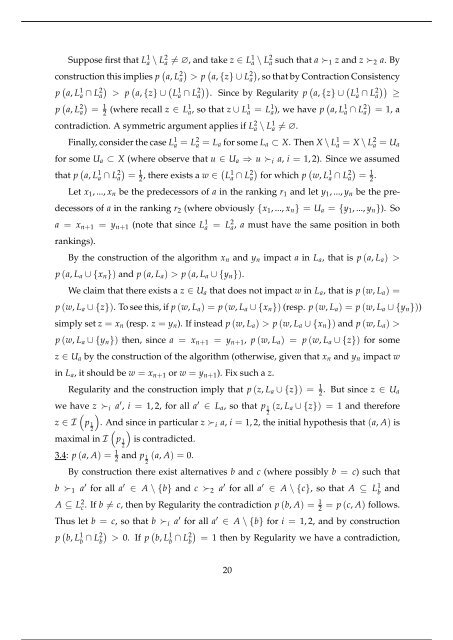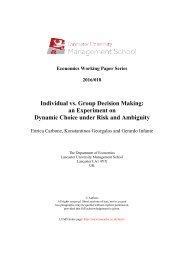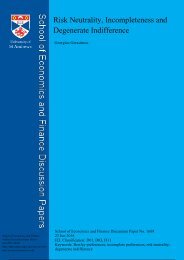Dual Random Utility Maximisation
n?u=RePEc:san:wpecon:1605&r=upt
n?u=RePEc:san:wpecon:1605&r=upt
Create successful ePaper yourself
Turn your PDF publications into a flip-book with our unique Google optimized e-Paper software.
Suppose first that L 1 a \ L 2 a ̸= ∅, and take z ∈ L 1 a \ L 2 a such that a ≻ 1 z and z ≻ 2 a. By<br />
construction this implies p ( a, L 2 ( )<br />
a) > p a, {z} ∪ L<br />
2<br />
a , so that by Contraction Consistency<br />
p ( a, L 1 a ∩ L 2 ( (<br />
a) > p a, {z} ∪ L<br />
1<br />
a ∩ L 2 ( (<br />
a))<br />
. Since by Regularity p a, {z} ∪ L<br />
1<br />
a ∩ L 2 a)) ≥<br />
p ( a, L 2 a) =<br />
1<br />
2<br />
(where recall z ∈ L 1 a, so that z ∪ L 1 a = L 1 a), we have p ( a, L 1 a ∩ L 2 a) = 1, a<br />
contradiction. A symmetric argument applies if L 2 a \ L 1 a ̸= ∅.<br />
Finally, consider the case L 1 a = L 2 a = L a for some L a ⊂ X. Then X \ L 1 a = X \ L 2 a = U a<br />
for some U a ⊂ X (where observe that u ∈ U a ⇒ u ≻ i a, i = 1, 2). Since we assumed<br />
that p ( a, L 1 a ∩ L 2 a) =<br />
1<br />
2<br />
, there exists a w ∈ ( L 1 a ∩ L 2 (<br />
a)<br />
for which p w, L<br />
1<br />
a ∩ L 2 a) =<br />
1<br />
2<br />
.<br />
Let x 1 , ..., x n be the predecessors of a in the ranking r 1 and let y 1 , ..., y n be the predecessors<br />
of a in the ranking r 2 (where obviously {x 1 , ..., x n } = U a = {y 1 , ..., y n }). So<br />
a = x n+1 = y n+1 (note that since L 1 a = L 2 a, a must have the same position in both<br />
rankings).<br />
By the construction of the algorithm x n and y n impact a in L a , that is p (a, L a ) ><br />
p (a, L a ∪ {x n }) and p (a, L a ) > p (a, L a ∪ {y n }).<br />
We claim that there exists a z ∈ U a that does not impact w in L a , that is p (w, L a ) =<br />
p (w, L a ∪ {z}). To see this, if p (w, L a ) = p (w, L a ∪ {x n }) (resp. p (w, L a ) = p (w, L a ∪ {y n }))<br />
simply set z = x n (resp. z = y n ). If instead p (w, L a ) > p (w, L a ∪ {x n }) and p (w, L a ) ><br />
p (w, L a ∪ {y n }) then, since a = x n+1 = y n+1 , p (w, L a ) = p (w, L a ∪ {z}) for some<br />
z ∈ U a by the construction of the algorithm (otherwise, given that x n and y n impact w<br />
in L a , it should be w = x n+1 or w = y n+1 ). Fix such a z.<br />
Regularity and the construction imply that p (z, L a ∪ {z}) =<br />
2 1. But since z ∈ U a<br />
we have z ≻ i a ′ , i = 1, 2, for all a ′ ∈ L a , so that p 1 (z, L a ∪ {z}) = 1 and therefore<br />
)<br />
2<br />
z ∈ I<br />
(p 1 . And since in particular z ≻ i a, i = 1, 2, the initial hypothesis that (a, A) is<br />
2 )<br />
maximal in I<br />
(p 1 is contradicted.<br />
2<br />
3.4: p (a, A) = 1 2 and p 2<br />
1 (a, A) = 0.<br />
By construction there exist alternatives b and c (where possibly b = c) such that<br />
b ≻ 1 a ′ for all a ′ ∈ A \ {b} and c ≻ 2 a ′ for all a ′ ∈ A \ {c}, so that A ⊆ L 1 b and<br />
A ⊆ L 2 c. If b ̸= c, then by Regularity the contradiction p (b, A) = 1 2<br />
= p (c, A) follows.<br />
Thus let b = c, so that b ≻ i a ′ for all a ′ ∈ A \ {b} for i = 1, 2, and by construction<br />
p ( b, L 1 b ∩ (<br />
b) L2 > 0. If p b, L<br />
1<br />
b<br />
∩ L 2 b) = 1 then by Regularity we have a contradiction,<br />
20






